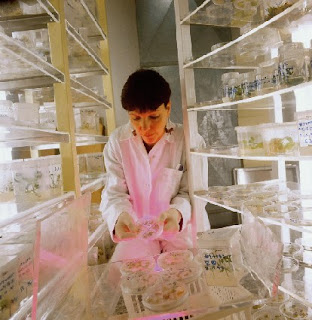 Move over, Darwin. Natural selection is sooooo yesterday. The future is in artificial selection–you know, genetic engineering. That’s right, you want a blue-eyed baby? No problem. Five pound strawberries–no problem. Cloned meat products? Yes. And now there may be a genetic solution to indolence. Intrigued? Read on.
Move over, Darwin. Natural selection is sooooo yesterday. The future is in artificial selection–you know, genetic engineering. That’s right, you want a blue-eyed baby? No problem. Five pound strawberries–no problem. Cloned meat products? Yes. And now there may be a genetic solution to indolence. Intrigued? Read on.
Scientists at UC Berkeley have found a gene that is responsible for turning carbohydrates into fat. The gene, called DNA-PK, works in the liver, regulating the conversion of sugars into fats. What this means is that that silly little process of turning low energy carbs into higher energy triglycerides is controlled by this one simple gene. Mice bred with a disabled version of the gene were able to eat large portions of carbohydrate meals–the equivalent of the all-you-can-eat-pasta bar–and still have 40% less body fat when compared to a control group of normal mice. And the implications for humans? The researcher team thinks it might be a great target for new drugs to help prevent obesity.
 Modern science never ceases to amaze me. Think about it, you can eat all you want–pizza, Ding Dongs, Fig Newtons for days–and not gain an ounce. What do you think? Brilliant, yes? Forget that our genetic makeup is the product of billions of years of evolution. Forget that natural selection is the selection of favorable traits that become more common in successive generations. And forget that there might be an evolutionary advantage to turning low energy carbohydrates into higher energy fats–trivialities all. What matters is that we can manipulate nature–Ta-Da!–cuz we can. Reminds me of that joke about why a dog licks his nards. Silly humans.
Modern science never ceases to amaze me. Think about it, you can eat all you want–pizza, Ding Dongs, Fig Newtons for days–and not gain an ounce. What do you think? Brilliant, yes? Forget that our genetic makeup is the product of billions of years of evolution. Forget that natural selection is the selection of favorable traits that become more common in successive generations. And forget that there might be an evolutionary advantage to turning low energy carbohydrates into higher energy fats–trivialities all. What matters is that we can manipulate nature–Ta-Da!–cuz we can. Reminds me of that joke about why a dog licks his nards. Silly humans.













